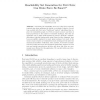1449 search results - page 194 / 290 » Time Synchronization |
APN
2004
Springer
14 years 2 months ago
2004
Springer
Generating the reachability set is one of the most commonly required step when analyzing the logical or stochastic behavior of a system modeled with Petri nets. Traditional “expl...
ASYNC
2003
IEEE
14 years 2 months ago
2003
IEEE
Parameterized first-order models for throughput, energy, and bandwidth are presented in this paper. Models are developed for many common pipeline methodologies, including clocked...
DATE
2010
IEEE
14 years 2 months ago
2010
IEEE
Abstract—In conventional static implementations for correlated streaming applications, computing resources may be inefficiently utilized since multiple stream processors may sup...
ICRA
2002
IEEE
14 years 2 months ago
2002
IEEE
Most robot programming takes place in the “time domain.” That is, the goal is to specify the behavior of a system that is acquiring a continual temporal stream of inputs, and ...
ISQED
2002
IEEE
14 years 2 months ago
2002
IEEE
All synchronous CMOS integrated systems have to pay some sequencing overhead. This overhead includes the skew and the jitter of the clock. It also includes the setup time and the ...

